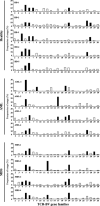Biased usage of BV gene families of T-cell receptors of WT1 (Wilms' tumor gene)-specific CD8+ T cells in patients with myeloid malignancies
- PMID: 20132220
- PMCID: PMC11158457
- DOI: 10.1111/j.1349-7006.2009.01453.x
Biased usage of BV gene families of T-cell receptors of WT1 (Wilms' tumor gene)-specific CD8+ T cells in patients with myeloid malignancies
Abstract
WT1 (Wilms' tumor gene 1) protein is a potent pan-tumor-associated antigen (TAA) and WT1-specific cytotoxic T lymphocytes (WT1 tetramer(+) CD8(+) T cells) are spontaneously induced in patients with acute myeloid leukemia (AML) or myelodysplastic syndrome (MDS). We conducted a single-cell level comparative analysis of T-cell receptor beta-chain variable region (TCR-BV) gene families of a total of 1242 spontaneously induced WT1 tetramer(+) CD8(+) T cells in HLA-A*2402(+) patients with AML or MDS and those in healthy donors (HDs). This is the first report of direct usage analysis of TCR-BV gene families of individual TAA-specific CD8(+) T cells at single-cell level. Usage analysis using single-cell RT-PCR of TCR-BV gene families of individual FACS-sorted WT1 tetramer(+) CD8(+) T cells showed for the first time (i) that BVs 5, 6, 20, and 27 were commonly biased in both HDs and patients; (ii) that BV4 was commonly biased in HDs and MDS patients; (iii) that BV19 was commonly biased in the patients; and (iv) that BVs 7 and 28, BVs 9 and 15, and BVs 12 and 29 were specifically biased in HDs, AML, and MDS patients, respectively. However, statistical analysis of similarity among HD, AML, and MDS of individual usage frequencies of 24 kinds of TCR-BV gene families indicated that the usage frequencies of TCR-BV gene families in AML and MDS patients reflect those in HDs. These findings represent a novel insight for a better understanding of WT1-specific immune response.
Figures




Similar articles
-
Biased usage of T cell receptor β-chain variable region genes of Wilms' tumor gene (WT1)-specific CD8+ T cells in patients with solid tumors and healthy donors.Cancer Sci. 2012 Mar;103(3):408-14. doi: 10.1111/j.1349-7006.2011.02163.x. Epub 2012 Jan 17. Cancer Sci. 2012. PMID: 22126448 Free PMC article.
-
Immune responses to WT1 in patients with AML or MDS after chemotherapy and allogeneic stem cell transplantation.Int J Cancer. 2016 Apr 1;138(7):1792-801. doi: 10.1002/ijc.29909. Epub 2015 Nov 27. Int J Cancer. 2016. PMID: 26519872
-
WT1-specific CD8 + cytotoxic T cells with the capacity for antigen-specific expansion accumulate in the bone marrow in MDS.Int J Hematol. 2021 May;113(5):723-734. doi: 10.1007/s12185-021-03083-0. Epub 2021 Jan 27. Int J Hematol. 2021. PMID: 33502734
-
Wilms' tumor 1 gene in hematopoietic malignancies: clinical implications and future directions.Leuk Lymphoma. 2020 Sep;61(9):2059-2067. doi: 10.1080/10428194.2020.1762884. Epub 2020 May 13. Leuk Lymphoma. 2020. PMID: 32401109 Review.
-
Wilms' Tumor Gene 1 (WT1) Peptide Vaccine Therapy for Hematological Malignancies: From CTL Epitope Identification to Recent Progress in Clinical Studies Including a Cure-Oriented Strategy.Oncol Res Treat. 2017;40(11):682-690. doi: 10.1159/000481353. Epub 2017 Oct 18. Oncol Res Treat. 2017. PMID: 29041012 Review.
Cited by
-
The evolution of malignant and reactive γδ + T cell clones in a relapse T-ALL case after allogeneic stem cell transplantation.Mol Cancer. 2013 Jul 12;12:73. doi: 10.1186/1476-4598-12-73. Mol Cancer. 2013. PMID: 23849082 Free PMC article.
-
Immunological efficacy of glypican-3 peptide vaccine in patients with advanced hepatocellular carcinoma.Oncoimmunology. 2017 Jul 11;6(10):e1346764. doi: 10.1080/2162402X.2017.1346764. eCollection 2017. Oncoimmunology. 2017. PMID: 29123959 Free PMC article.
-
Functional human Th17 clones with WT1-specific helper activity.Cancer Immunol Immunother. 2013 Apr;62(4):801-10. doi: 10.1007/s00262-012-1385-3. Epub 2012 Dec 29. Cancer Immunol Immunother. 2013. PMID: 23275045 Free PMC article.
-
Single-cell T-cell receptor-β analysis of HLA-A*2402-restricted CMV- pp65-specific cytotoxic T-cells in allogeneic hematopoietic SCT.Bone Marrow Transplant. 2014 Jan;49(1):87-94. doi: 10.1038/bmt.2013.122. Epub 2013 Aug 12. Bone Marrow Transplant. 2014. PMID: 23933763
-
Polyclonal rabbit anti-murine plasmacytoma cell globulins induce myeloma cells apoptosis and inhibit tumour growth in mice.Apoptosis. 2011 Apr;16(4):370-81. doi: 10.1007/s10495-010-0568-7. Apoptosis. 2011. PMID: 21197579 Free PMC article.
References
-
- Drummond IA, Madden SL, Rohwer‐Nutter P, Bell GI, Sukhatme VP, Rauscher FJ 3rd. Repression of the insulin‐like growth factor II gene by the Wilms tumor suppressor WT1. Science 1992; 257: 674–8. - PubMed
-
- Goodyer P, Dehbi M, Torban E, Bruening W, Pelletier J. Repression of the retinoic acid receptor‐alpha gene by the Wilms’ tumor suppressor gene product, wt1. Oncogene 1995; 10: 1125–9. - PubMed
-
- Hewitt SM, Hamada S, McDonnell TJ, Rauscher FJ 3rd, Saunders GF. Regulation of the proto‐oncogenes bcl‐2 and c‐myc by the Wilms’ tumor suppressor gene WT1. Cancer Res 1995; 55: 5386–9. - PubMed
-
- Inoue K, Sugiyama H, Ogawa H et al. WT1 as a new prognostic factor and a new marker for the detection of minimal residual disease in acute leukemia. Blood 1994; 84: 3071–9. - PubMed
Publication types
MeSH terms
Substances
LinkOut - more resources
Full Text Sources
Other Literature Sources
Medical
Research Materials
Miscellaneous

